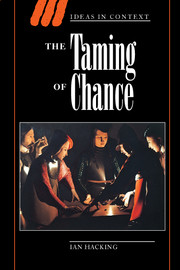Book contents
- Frontmatter
- Contents
- Acknowledgements
- 1 The argument
- 2 The doctrine of necessity
- 3 Public amateurs, secret bureaucrats
- 4 Bureaux
- 5 The sweet despotism of reason
- 6 The quantum of sickness
- 7 The granary of science
- 8 Suicide is a kind of madness
- 9 The experimental basis of the philosophy of legislation
- 10 Facts without authenticity, without detail, without control, and without value
- 11 By what majority?
- 12 The law of large numbers
- 13 Regimental chests
- 14 Society prepares the crimes
- 15 The astronomical conception of society
- 16 The mineralogical conception of society
- 17 The most ancient nobility
- 18 Cassirer's thesis
- 19 The normal state
- 20 As real as cosmic forces
- 21 The autonomy of statistical law
- 22 A chapter from Prussian statistics
- 23 A universe of chance
- Notes
- Index
- Ideas in Context
16 - The mineralogical conception of society
Published online by Cambridge University Press: 05 June 2014
- Frontmatter
- Contents
- Acknowledgements
- 1 The argument
- 2 The doctrine of necessity
- 3 Public amateurs, secret bureaucrats
- 4 Bureaux
- 5 The sweet despotism of reason
- 6 The quantum of sickness
- 7 The granary of science
- 8 Suicide is a kind of madness
- 9 The experimental basis of the philosophy of legislation
- 10 Facts without authenticity, without detail, without control, and without value
- 11 By what majority?
- 12 The law of large numbers
- 13 Regimental chests
- 14 Society prepares the crimes
- 15 The astronomical conception of society
- 16 The mineralogical conception of society
- 17 The most ancient nobility
- 18 Cassirer's thesis
- 19 The normal state
- 20 As real as cosmic forces
- 21 The autonomy of statistical law
- 22 A chapter from Prussian statistics
- 23 A universe of chance
- Notes
- Index
- Ideas in Context
Summary
I applied to the observation of human societies rules analogous to those used in the study of plants and minerals; in other words I created a method that allowed me to know personally all the nuances of peace and discord, of prosperity and suffering, which are found in contemporary European society.
The dusty collection of numbers invited parody as soon as public statistics were under way in the 1820s. The jokes were feeble and are best forgotten, with one exception. Balzac's Physiology of Marriage began with meditations headed ‘conjugal statistics’. The first printing of 1826 had 20 octavo pages on this unpromising topic. The second and standard version of 1829 had 62. What began as a spoof ended by making Balzac think hard. ‘In 1826 the notion of conjugal statistics furnished Balzac only with an amusing idea’ writes Bardèche, first modern editor of the obscure printing of 1826; ‘the additions of 1829 show us that Balzac's mind had become oriented towards very different reflections. What in 1826 had been a matter for simple calculation, became in 1829 a general view of society, a sort of panorama of the French bourgeoisie.’ Statistics directed him towards the human comedy.
The Physiology had lots of targets other than statistics. Its very title and a chapter on hygiene made fun of Broussais's ‘physiological’ school of medicine. Balzac may have had in mind another title (it is written in his notes): ‘the marital code, or the art of keeping one's wife faithful’. In the end the piece was subtitled ‘Eclectic philosophical meditations on conjugal happiness and unhappiness’.
- Type
- Chapter
- Information
- The Taming of Chance , pp. 133 - 141Publisher: Cambridge University PressPrint publication year: 1990

